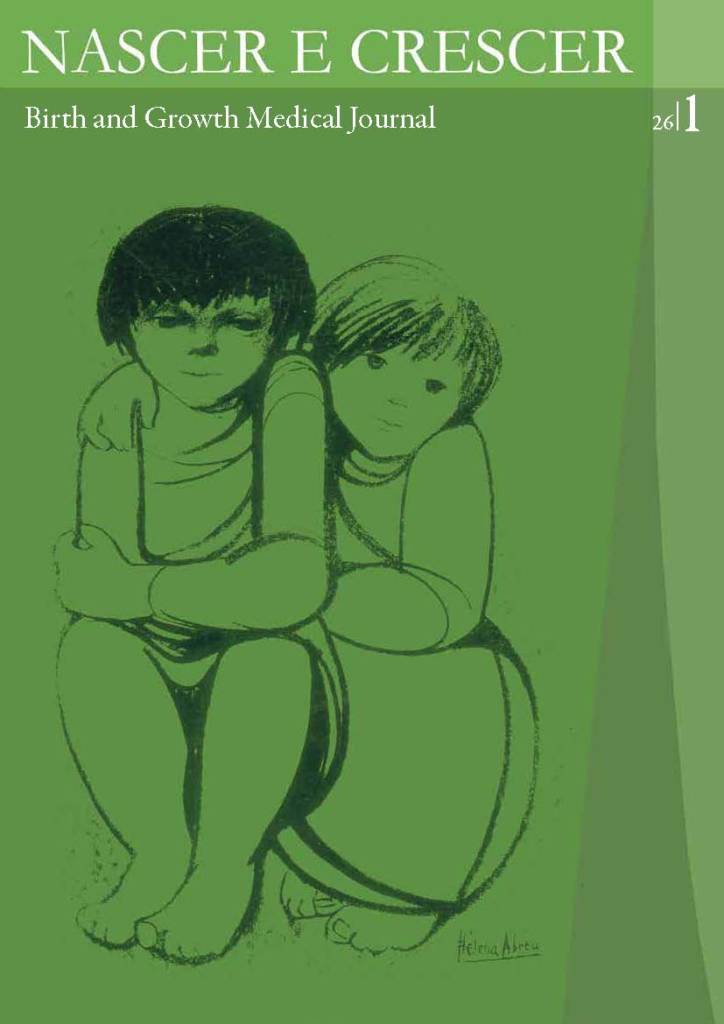BELLY DANCER'S SYNDROME - A DIAGNOSTIC CHALLANGE
DOI:
https://doi.org/10.25753/BirthGrowthMJ.v26.i1.11802Keywords:
Belly Dancer’s syndrome, abdominal movements, adolescence, trauma, involuntary movementsAbstract
Introduction: Belly Dancer’s syndrome is a rare movement disorder characterized by involuntary contractions of the diaphragm, causing abnormal movements in the abdominal wall. Many different causes were described such as trauma, infections, metabolic disorders and drug ingestion. Sometimes the cause remains uncertain and a psychogenic disturb has been suggested in others.
Case report: A 14-year-old female presented with episodic involuntary movements of the abdomen that had started one week after falling. Besides these abnormal movements, physical examination was unremarkable. Belly Dancer’s syndrome was suspected and the neuroimaging revealed C3 and C4 nerve root injuries and several vertebral lesions. The treatment performed included oral chlorpromazine, immobilization with Jewett vest, rest and physiotherapy, with remarkable symptoms improvement.
Discussion: This clinical presentation of this syndrome is quite unusual, which may lead to late diagnosis or ineffective treatments. We report a case of traumatic Belly Dancer’s syndrome that improved significantly with stabilization of the lesion.
Downloads
References
Phillips JR, Eldridge FL. Respiratory myoclonus (Leeuwenhoek’s disease). N Engl J Med. 1973 Dec 27;289:1390-5.
Rigatto M, Medeiros N. Diaphragmatic flutter. Report of a case and review of literature. Am J Med. 1962 Jan;32:103-9.
Inglhilleri M, Conte A, Frasca V, et al. Belly Dance Syndrome Due to Spinal Myoclonus. Mov Disord. 2006; 2:394-6.
Patterson V. Belly Dancer’s Syndrome: causes, clinical presentations, and treatment. In: http://www.logan.edu/mm/
files/LRC/Senior-Research/2011-Dec-31.pdf. Accessed Jun 2014.
Romanes GJ. Cunningham’s manual of practical anatomy. Oxford: Oxford University Press; 1986.
Iliceto G, Thompson PD, Day BL, et al. Diaphragmatic flutter, the moving umbilicus syndrome, and “belly dancer’s” dyskinesia. Mov Disord. 1990;5:15-22.
Alvarez MV, Driver-Dunckley EE, Caviness JN, et al. Case series of painful legs and moving toes: clinical and electrophysiologic observations. Mov Disord. 2008;23:2062-6.
Chen, R. Remtulla, H. Bolton, C. Electrophysiological study of diaphragmatic myoclonus. J Neurol Neurosurg Psychiatry. 1995; 58:480-3.
Katz ES, Gauda E, Crawford T, et al. Respiratory flutter syndrome an underrecognized cause of respiratory failure in neonates. Am J Respir Crit Care Med. 2001;164:1161-4.
Ramírez JD, Gonzales M, Hoyos JA, Grisales L. Aleteo diafragmático. Descripción de caso y revisión de la literatura. Neurología. 2015;30:249-51.
Panigrahy N, Kumar PP and Chirla DK. Respiratory Flutter Symdrome in a Neonate. Indian Pediatr 2013;50:242-3.
Downloads
Published
How to Cite
Issue
Section
License
Copyright and Authors' Rights
All articles published in Nascer e Crescer - Birth and Growth Medical Journal are Open Access and comply with the requirements of funding agencies or academic institutions. For use by third parties, Nascer e Crescer - Birth and Growth Medical Journal adheres to the terms of the Creative Commons License "Attribution - Non-Commercial Use (CC-BY-NC)".
It is the author's responsibility to obtain permission to reproduce figures, tables, etc. from other publications.
Authors must submit a Conflict of Interest statement and an Authorship Form with the submission of the article. An e-mail will be sent to the corresponding author confirming receipt of the manuscript.
Authors are permitted to make their articles available in repositories at their home institutions, provided that they always indicate where the articles were published and adhere to the terms of the Creative Commons license.


